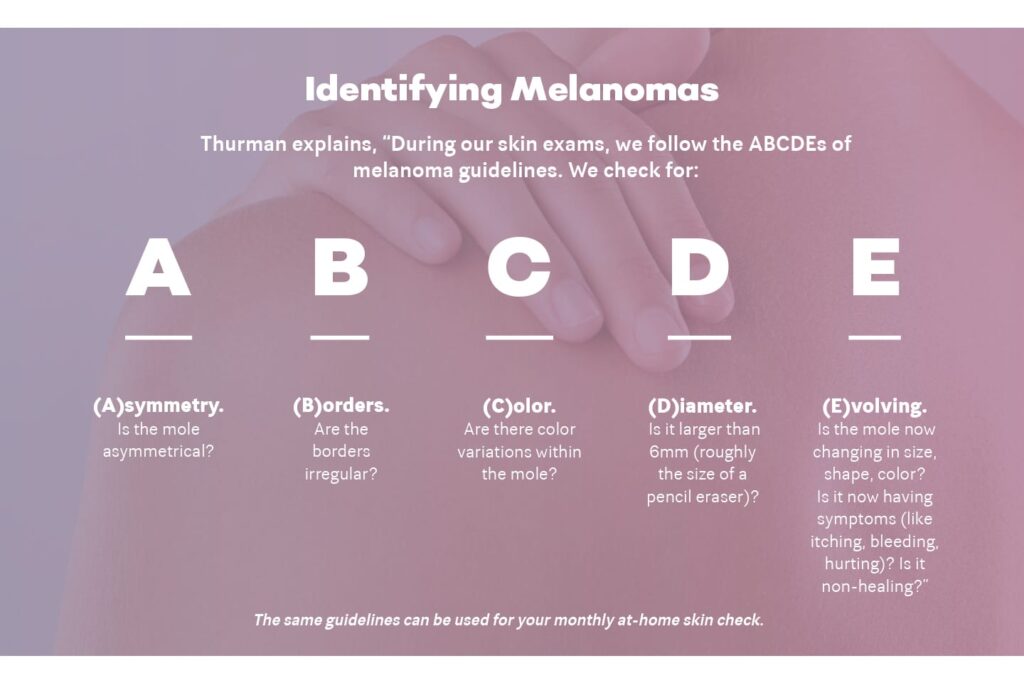For the 1 in 5 Americans that will develop skin cancer in their lifetime, early diagnosis and treatment are key.
There’s a reason you keep hearing about skin cancer – it’s the most common cancer in the United States with roughly 9,500 new diagnoses each day. Nondiscriminatory, it can affect anyone, regardless of age, gender, or race. Close to 600,000 people in the United States die each year from the disease, but there’s hope: if detected early, almost all cases can be treated.
The Big Three

The three major types of skin cancer you should be aware of are basal cell carcinoma, squamous cell carcinoma, and melanoma.
Basal Cell Carcinoma
Named after the type of cell that becomes cancerous, basal cell carcinoma (BCC) is the most common type of skin cancer, accounting for 3 in 4 diagnoses. The head, neck, and arms – the areas of your skin that get the greatest sun exposure – are the most common places it presents, but on rarer occasions, it can crop up in unexpected locations like the genitals.
This type of skin cancer doesn’t typically metastasize (spread to other parts of the body), but it can cause serious damage to surrounding areas if not caught early. Ashley Thurman, a dermatology certified nurse practitioner with Skin Cancer & Cosmetic Dermatology, explains, “If not caught early, basal cell carcinoma can destroy surrounding tissue and bone structure. If a lesion on the head or face is left untreated, it can spread to the brain, sinus cavities, eyes, and mouth.”
What to look for: Basal cell carcinomas usually appear as pearly or translucent bumps. These bumps will have tiny blood vessels in them, though they might be hard to spot. They can also appear flat or crusted, or may look like a pimple that doesn’t heal or bleeds easily.
Squamous Cell Carcinoma
The second most common type of skin cancer, squamous cell carcinoma (SCC), is often seen on areas that see the most sun like the face, ears, neck, arms, and chest.
This type of skin cancer is more likely to metastasize than BCC, but the probability is pretty low. However, it can still affect the surrounding tissue and cause damage. Dr. Deanna Brown, a dermatologist with Susong Dermatology and on staff at CHI Memorial, explains, “Squamous cell carcinomas have a slightly higher chance of spreading to lymph nodes or other organs, particularly if they grow deep in the skin or are located on high risk areas like the lips, ears, fingers, or genitals.”
What to look for: Squamous cell carcinomas generally present as red or brown bumps or patches of skin that have a rough, scaly surface. They can have raised borders and appear crusted in the center. If scratched or bumped, they may bleed.
Melanoma
Melanoma may be the least common form of skin cancer, but it’s also the deadliest. It occurs when melanocytes become cancerous. These cells form moles and make melanin, the brown pigment that gives skin its color. This type of skin cancer can develop from a mole you already have, or it can pop up as a new skin lesion. Frequently, melanomas start on the chest, back, or legs, but they can develop anywhere, even the bottoms of feet or under the nails. And unfortunately, melanomas metastasize quickly.


What to look for: “Melanomas can vary in their appearance,” explains Thurman. “Most people think of them as a black mole, which is often how they present, but they can also be pink, white, or even tan.”
What Increases Your Risk?
“We know that UV exposure – both natural (from the sun) and artificial (from tanning beds) – causes damage to your skin at a molecular level and is the most common cause of skin cancer,” says Dr. Brown. “But having a history of blistering sunburns in childhood and/or a tendency to burn rather than tan also increases your chance of developing skin cancer, particularly melanoma.”
Sun exposure isn’t the only risk factor. Anyone with a parent, sibling, or child who has or had skin cancer is considered high risk, since genetics play a factor in your body’s ability to repair damage done by UV radiation. And speaking of genetics, those with a fair complexion, red hair, or light-colored eyes are also at a higher risk.
However, while those with fairer skin are at an increased risk for skin cancer, that doesn’t mean individuals with darker skin are in the clear. “People with a darker skin tone have a far lower risk of developing skin cancer, but it does happen,” explains Dr. Maren Shaw, a dermatologist with Chattanooga Skin and Cancer Clinic. “In these cases, it’s typically diagnosed at a later stage, which makes it more difficult to treat.”
Skin Cancer Symptoms You Can’t See


Signs are visible on the skin 99% of the time, but in some rare cases, your body might be telling you that you have skin cancer through non-visual cues that should be investigated by a doctor:
Lumps Under Your Skin – If you feel lumps beneath your skin – especially in areas like your groin, armpit, or neck – those may be an indication of skin cancer that has spread to your lymph nodes.
Abdominal Pain – Melanoma can spread to other parts of your body – even to your liver. If that happens, you may experience pain in the upper right quadrant of your abdomen.
Aching Joints – If you are experiencing arthritis-like conditions like joint pain, it could signify that your skin cancer has spread to your bones.
Blurred Vision – Melanocytes, the pigment-producing cells that cause melanomas, are found primarily in your skin but also in your eyes and other parts of the body. If you develop a melanoma in or around your eye, you may encounter blurry or impaired vision.
Headaches – Your brain also contains melanocytes. That means it is possible for a melanoma to start on your skin and travel to your brain. If that is the case, you might experience symptoms such as headaches, seizures, or cognitive problems.
Itchiness – Basal cell carcinomas can resemble noncancerous skin conditions such as psoriasis or eczema, which means they might be itchy. An itchy mole, especially without preceding trauma or irritation from clothing, can be a warning sign.
Breathing Issues – If melanoma spreads to the lungs, it can present as shortness of breath or a persistent cough. Although the odds of such side effects being caused by melanoma are low, it is still important to consult a doctor.
Protecting Yourself


Summer is synonymous with fun in the sun. So don’t worry, be happy – as long as you’re protecting yourself. If you notice anything that looks even the slightest bit suspicious, visit your dermatologist. Early detection is key for effective treatment!"
The easiest way to lower your risk of developing skin cancer is by reducing your exposure to UV radiation. “The American Academy of Dermatology encourages everyone to protect their skin from the sun’s harmful UV rays by seeking shade, wearing protective clothing, and using a sunscreen with an SPF of 30 or higher,” says Dr. Shaw.
This includes eliminating all visits to the tanning bed. Dr. Shaw continues, “Studies show that tanning bed use before age 35 can increase the risk of melanoma by 59%, and the risk increases with each use.”
Yearly skin checks aren’t just a suggestion, either. Dr. Brown explains, “Visit a board-certified dermatologist for a baseline skin exam if you’ve never had one. We can recognize many skin cancers when they are early and easily treatable – often before you even realize something is wrong.”


Ashley Thurman
Dermatology Certified Nurse Practitioner, Skin Cancer & Cosmetic Dermatology


Dr. Deanna Brown
Dermatologist, Susong Dermatology and CHI Memorial


Dr. Maren Shaw
Dermatologist, Chattanooga Skin and Cancer Clinic

